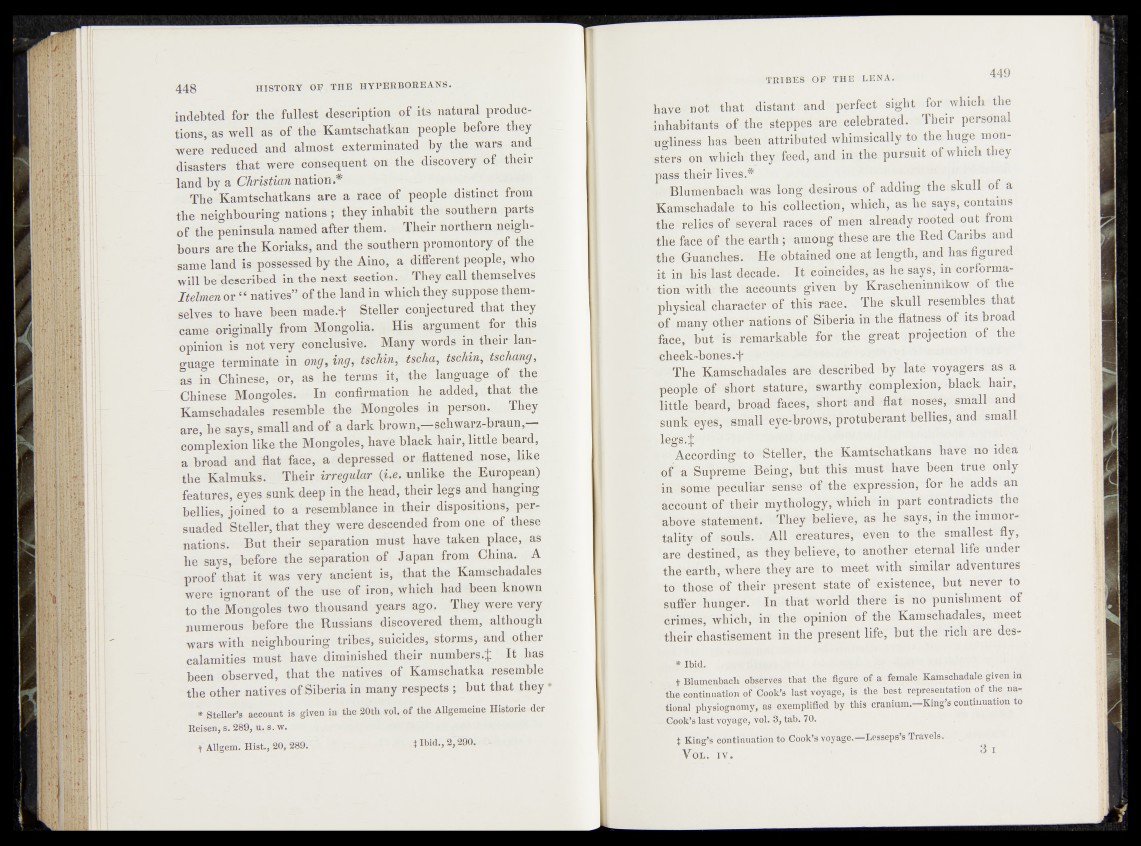
indebted for the fullest description of its natural productions,
as well as of the Kamtschatkan people before they
were reduced and almost exterminated by the wars and
disasters that were consequent on. the discovery of their
land by a Christian nation
The Kamtschatkans are a race of people distinct from
the neighbouring nations ; they inhabit the southern parts
of the peninsula named after them. Their northern neighbours
are the Koriaks, and the southern promontory of the
same land is possessed by the Aino, a different people, who
will be described in the next section. They call themse'l*ve|;
lielmen or “ natives” of the land in which they suppose themselves
to have been made.f Steller conjectured that they
came originally from Mongolia. His argument for this
opinion is not very conclusive. Many words in their language
terminate in ong, ing, tschin, tscha, tscJrin, tschang,
as in Chinese, or, as he terms it, the language:, of ■ the
Chinese Mongoles. In confirmation he added, that the
Kamschadales resemble the Mongolesin person. They
are, he says, small and of a dark brown,—schwarz-braun,—
complexion like the Mongoles, have black hair, little bedrd,
a broad and flat face, a depressed or flattened nose, like
the Kalmuks. Their irregular unlike the European)
features, eyes sunk deep in the head, their legs and hanging
bellies, joined to a resemblance in their dispositions, per-?
suaded Steller, that they were descended from one of these
nations. But their separation must have taken place, as
he says, before the separation of Japan from China. A
proof that it was very ancient is, that the Kamschadales
were ignorant of the use of iron, which had been known
to the Mongoles two thousand years ago. They were very
numerous before the Russians discovered them, although
wars with neighbouring tribes, suicides, storms, and other
calamities must have diminished their numbers.^ It has
been observed, that the natives of Kamschatka resemble
the other natives of Siberia in many respects ; but that they
* atelier’s account is given in the 30th vol. of the Allgemeine Historie der
Reisen, 8.289, u. 8, w.
t Allgem. Hist., 20, 289; X Ibid., 2,290.
TRIBES OF THE LENA,
have^hot that 'd0tëo4 and perfect sight for which the
inhabitants-of tH^-steppes are celebrated. Their personal
ugliness Ms 'been , attributèdi whimsically to the huge mon-
stersr tm whi<çWtheJ#fëed>, and in-the pursuit of which they
pass their M^es,f iw?. •• i .
Blumbnbachv was longkfesirous of adding the skull of a
Kamsehadale to hi^cu'llection, which, as,he says, contains
the' relie#?of/‘Sêveral races-of vmen alreadyorooted »out from
the face of.tK^artli ; among^theSe are/the Red Caribs and
the Guanches. He s t a t e d one at length, and has figured
^ in his lastdeeatfe. I t èmnicÉdesi^M^s;dn;corforina-
tion with th£-îaMoüntsV#veh4f# Krascheninnikow fof the
physical character* ©f this^cel, The skuffl resembles that
of many other'nations of Siberia in tlie flatness,of its broad
face, b u t! is remarkablè for the great .projection of the
cheekdaotiesif ^ jM SIÉSBpjj V' ®
The Kamschadales are described by flute voyagers: as a
f é o p i 6f short statu-rë,ï swarthy ^complexion, *blaek hair,
little beard, broad faces*, shorte and ‘flat noses, small'and
sunk« eyes, small e/e^brows, protuberant feèllies, and ’small
-legs.J •' • y ■
According»»to ^Steller, the Kamtschatkans have no idea
of a Supreme Being, but this must have been true only
in some peculiar sense^bf the expression, fcfr he adds an
account of their mythology, which in part contradicts the
above statement. They believë'f as he saysfin the immortality
of » souls. All creatures) ^ e n to the fimallesfc fly,
are "destined, as they belève-ÿdo another .eternal life' under
the earth, where they are to meet with similar adventures
to those of their present state of existence,'«but never to
suffer hunger. In that world there Is no punishment of
crimes, which, in the opinion of the Kamschadales,. meet
their chastisement in the present life) but the rich are des-
* Ibid,
+ Rlumenbach observes .that the figure .of. a female Kamsehadale given in
the continuation o f Cqok’s last voyage, is the best-representation of the, national
physiognomy, as exemplified by this cranium.—King’s continuation to
—- Cook’s last voyage, vgl. 8, tab. 70.
X King’s continuation to Cook’s voyage.—Lesseps’s Travels.
VOL. IV. ' ^ 1